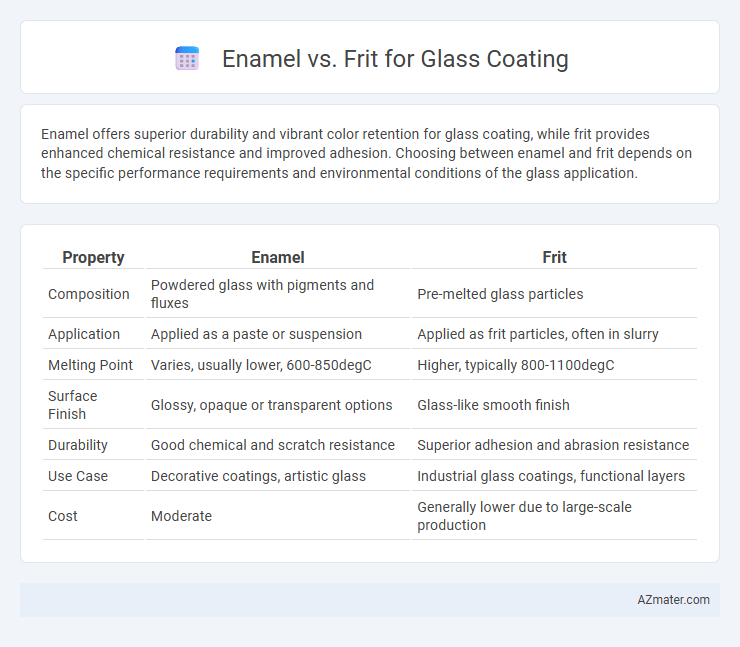Enamel offers superior durability and vibrant color retention for glass coating, while frit provides enhanced chemical resistance and improved adhesion. Choosing between enamel and frit depends on the specific performance requirements and environmental conditions of the glass application.
Table of Comparison
| Property | Enamel | Frit |
|---|---|---|
| Composition | Powdered glass with pigments and fluxes | Pre-melted glass particles |
| Application | Applied as a paste or suspension | Applied as frit particles, often in slurry |
| Melting Point | Varies, usually lower, 600-850degC | Higher, typically 800-1100degC |
| Surface Finish | Glossy, opaque or transparent options | Glass-like smooth finish |
| Durability | Good chemical and scratch resistance | Superior adhesion and abrasion resistance |
| Use Case | Decorative coatings, artistic glass | Industrial glass coatings, functional layers |
| Cost | Moderate | Generally lower due to large-scale production |
Understanding Glass Coating Technologies
Enamel and frit represent two essential glass coating technologies, each offering distinct advantages in durability and aesthetics for architectural and automotive applications. Enamel coatings consist of finely ground glass particles mixed with pigments that fuse to the substrate at high temperatures, providing a smooth, colorful, and chemically resistant surface. Frit coatings, created by melting and rapidly cooling glass, produce a more uniform layer that enhances thermal stability and corrosion resistance, making them ideal for protective and functional glass treatments.
What is Enamel for Glass Coating?
Enamel for glass coating is a powdered glass made from silica, fluxes, and colorants that fuses to the glass surface when heated to high temperatures. This coating provides a durable, decorative, and protective layer that resists scratches, chemicals, and UV radiation. Enamel ensures enhanced aesthetic appeal and long-lasting performance on glass products used in automotive, architectural, and art applications.
What is Frit for Glass Coating?
Frit for glass coating is a powdered glass mixture that melts during the firing process to form a smooth, durable, and protective layer on glass surfaces. It consists primarily of silica, fluxes, and stabilizers, designed to adhere firmly and withstand environmental exposure, enhancing glass durability and aesthetic appeal. Frit offers superior chemical and weather resistance compared to traditional enamel coatings, making it ideal for architectural and industrial glass applications.
Key Differences Between Enamel and Frit
Enamel and frit differ primarily in composition and application methods for glass coating; enamel consists of finely ground glass mixed with pigments and requires firing on glass surfaces at lower temperatures, while frit is crushed glass particles often used as a base layer or intermediate coating that undergoes higher temperature fusing. Enamel provides vibrant colors and precise decorative details suitable for artistic and functional glassware, whereas frit offers durability and structural integrity, enhancing glass strength and thermal resistance. The key difference lies in enamel's role as a colorant and decorative medium compared to frit's function as a bonding and reinforcing agent in glass manufacturing.
Application Processes: Enamel vs Frit
Enamel coating involves applying finely ground glass mixed with pigments onto a substrate, followed by firing at high temperatures to create a smooth, durable surface ideal for decorative and protective finishes. In contrast, frit coating uses pre-melted, crushed glass particles that are typically fused onto the glass substrate through a single firing process, offering excellent weather resistance and chemical durability. The enamel process allows for more intricate designs and color variations, while frit coatings provide uniform texture and are commonly used in architectural glass applications for enhanced performance.
Durability and Performance Comparison
Enamel coatings on glass offer superior chemical resistance and high-temperature durability, making them ideal for industrial and decorative applications requiring long-lasting color retention. Frit coatings provide excellent adhesion and thermal shock resistance due to their fused glass composition, enhancing surface hardness and scratch resistance. Comparing durability, enamel excels in resisting corrosion and fading, while frit demonstrates greater mechanical strength and environmental resilience under rapid temperature changes.
Aesthetic and Color Options
Enamel coatings offer vibrant, glossy finishes with a broad spectrum of colors, providing exceptional aesthetic appeal ideal for decorative glass projects. Frit coatings deliver a more muted, textured look with unique matte or semi-gloss finishes, often preferred for architectural glass applications requiring subtle color variations. Both enamel and frit enable customizable color options, but enamel's rich pigmentation supports high-detail designs, while frit's granular texture enhances durability and visual depth.
Cost Implications for Enamel and Frit
Enamel coatings generally involve higher initial costs due to the complex formulation and labor-intensive application process, but they offer enhanced durability and chemical resistance that can reduce long-term maintenance expenses. Frit coatings are more cost-effective upfront because of simpler production and easier application methods, though they may require more frequent recoating or touch-ups over time. Selecting between enamel and frit depends on balancing initial investment with projected lifecycle costs and specific glass application requirements.
Common Uses in Various Industries
Enamel coatings are widely used in the automotive and appliance industries for their durability and vibrant color retention on metal surfaces, offering excellent resistance to corrosion and heat. Frit coatings are predominantly utilized in architectural glass and decorative glass manufacturing, providing enhanced surface hardness and chemical resistance while allowing for customized aesthetic finishes. Both materials serve critical roles in electronics and cookware industries, where enamel is favored for insulating properties and frit for its ability to fuse onto glass surfaces.
Choosing the Right Coating: Enamel or Frit?
Choosing the right glass coating depends on the application requirements, with enamel offering superior durability and vibrant color options ideal for decorative and architectural purposes. Frit coatings provide excellent thermal resistance and improved mechanical strength, making them suitable for functional uses such as solar control and safety glazing. Evaluating factors like environmental exposure, aesthetic preferences, and performance needs ensures the optimal selection between enamel and frit coatings for glass surfaces.

Infographic: Enamel vs Frit for Glass Coating
 azmater.com
azmater.com